Analysis of Negotiation, RFP, and Contractual Processes Report
VerifiedAdded on 2020/06/04
|12
|2713
|62
Report
AI Summary
This report provides an executive summary of negotiation, RFP, and contractual processes. It defines negotiation as a process for resolving issues and conflicts, emphasizing the importance of mutual agreements and beneficial outcomes for involved parties. The report details the negotiation process, including preparation, ground rules, clarification, bargaining, and implementation. It also covers key stakeholders and potential issues such as time constraints and emotional detachment. Furthermore, the report explains the Request for Proposal (RFP) process, its documents, and legal considerations, illustrated with an example from Save the Children. Finally, it discusses the contractual process, including required documents, competitive tendering, and recommendations for minimizing risks. This report is a valuable resource for understanding negotiation and business development strategies.
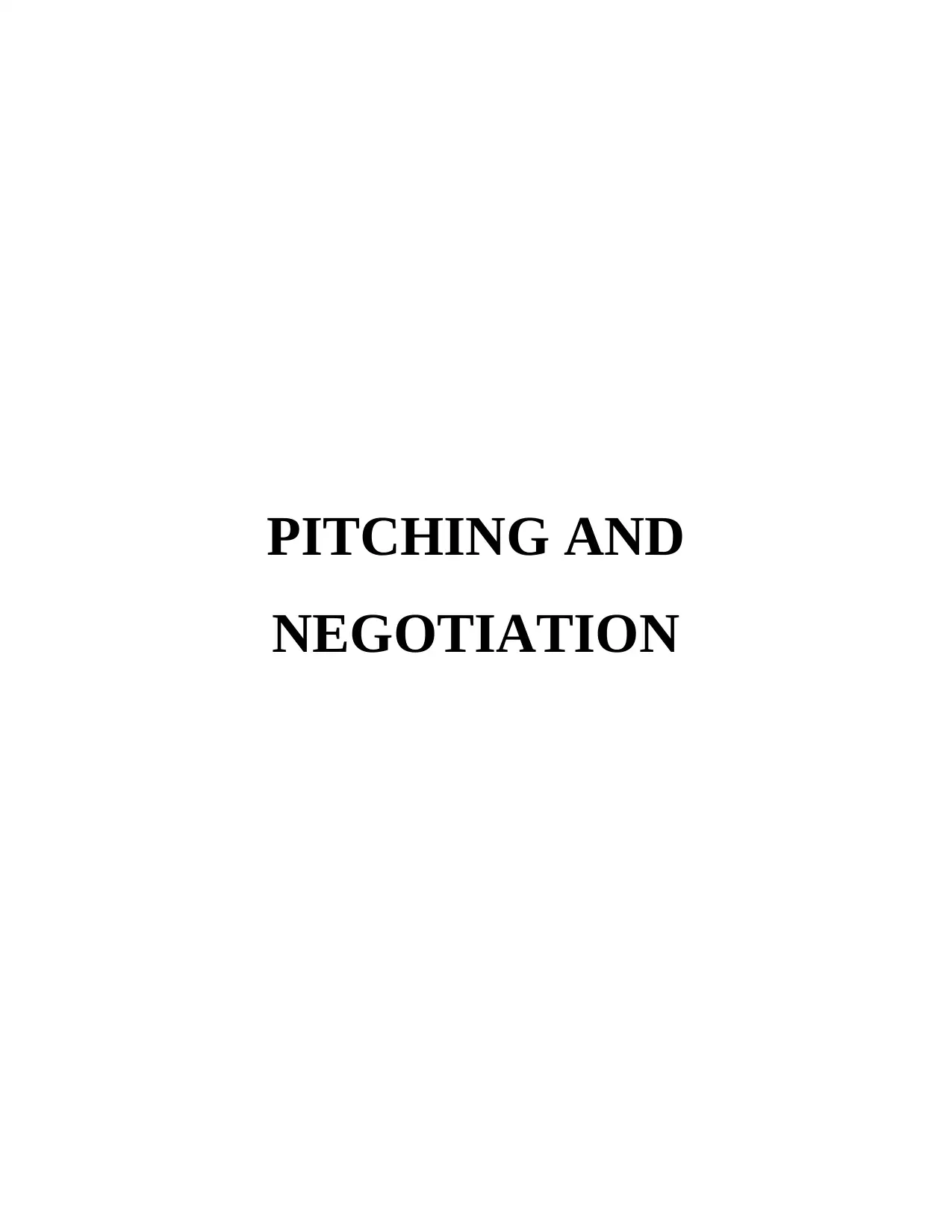
PITCHING AND
NEGOTIATION
NEGOTIATION
Paraphrase This Document
Need a fresh take? Get an instant paraphrase of this document with our AI Paraphraser
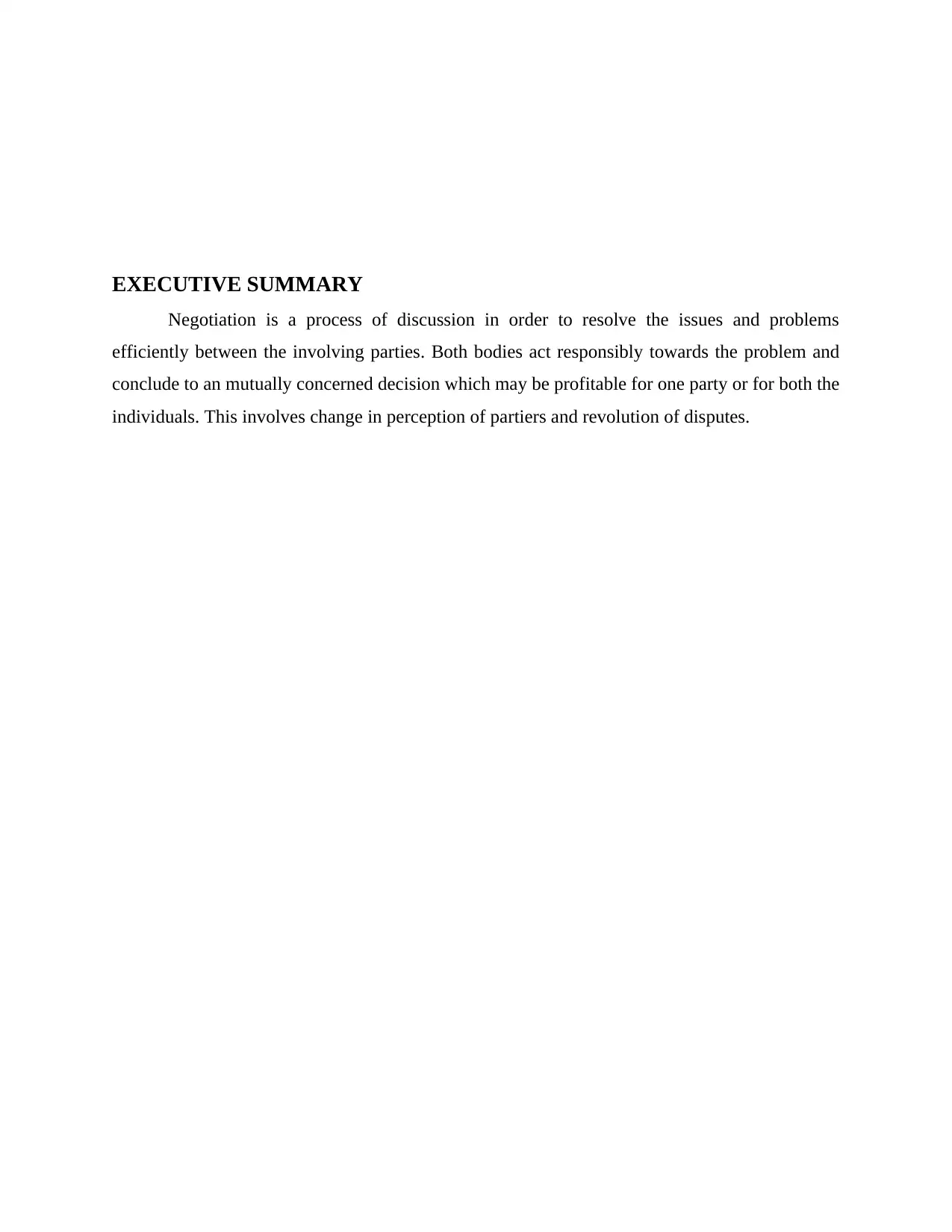
EXECUTIVE SUMMARY
Negotiation is a process of discussion in order to resolve the issues and problems
efficiently between the involving parties. Both bodies act responsibly towards the problem and
conclude to an mutually concerned decision which may be profitable for one party or for both the
individuals. This involves change in perception of partiers and revolution of disputes.
Negotiation is a process of discussion in order to resolve the issues and problems
efficiently between the involving parties. Both bodies act responsibly towards the problem and
conclude to an mutually concerned decision which may be profitable for one party or for both the
individuals. This involves change in perception of partiers and revolution of disputes.
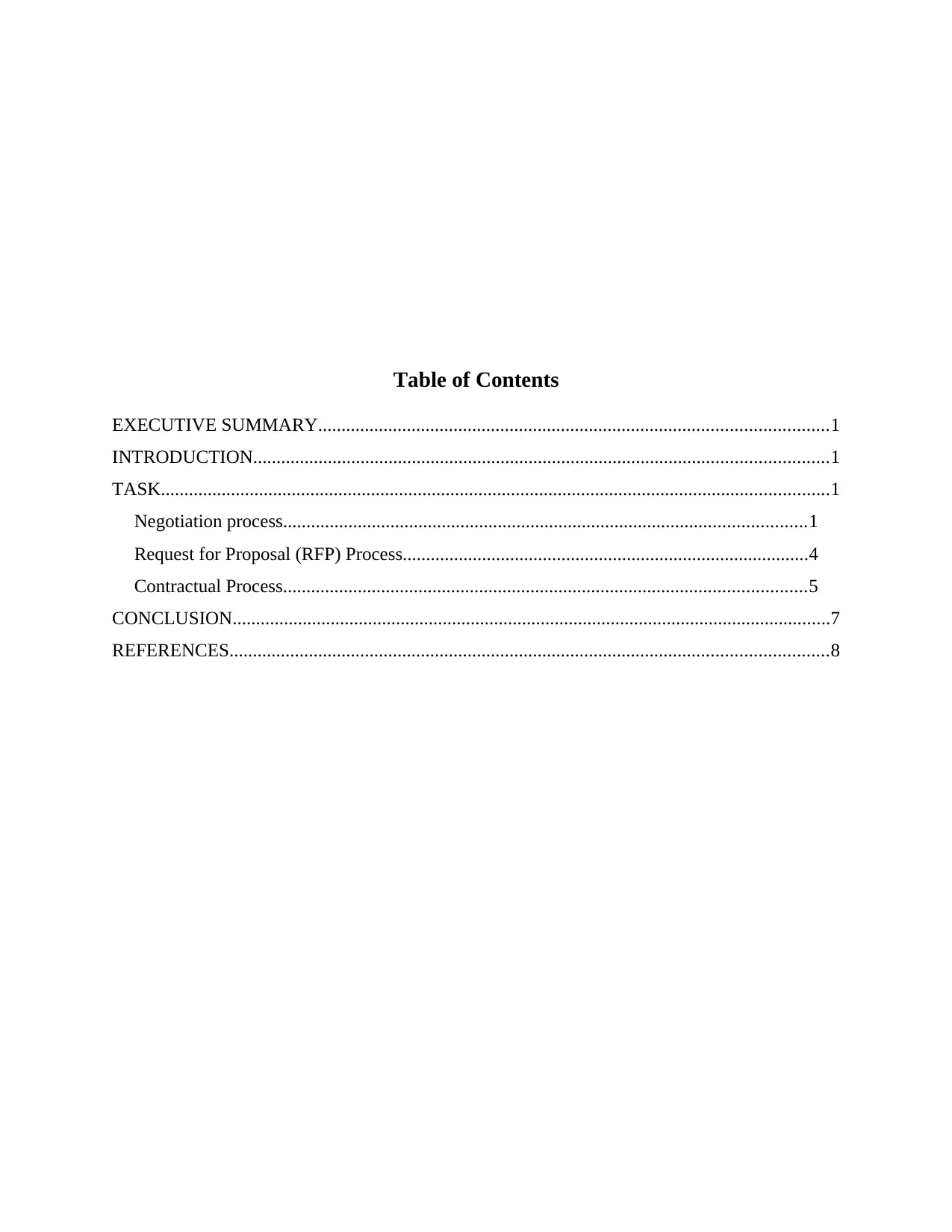
Table of Contents
EXECUTIVE SUMMARY.............................................................................................................1
INTRODUCTION...........................................................................................................................1
TASK...............................................................................................................................................1
Negotiation process................................................................................................................1
Request for Proposal (RFP) Process.......................................................................................4
Contractual Process................................................................................................................5
CONCLUSION................................................................................................................................7
REFERENCES................................................................................................................................8
EXECUTIVE SUMMARY.............................................................................................................1
INTRODUCTION...........................................................................................................................1
TASK...............................................................................................................................................1
Negotiation process................................................................................................................1
Request for Proposal (RFP) Process.......................................................................................4
Contractual Process................................................................................................................5
CONCLUSION................................................................................................................................7
REFERENCES................................................................................................................................8
⊘ This is a preview!⊘
Do you want full access?
Subscribe today to unlock all pages.

Trusted by 1+ million students worldwide

Paraphrase This Document
Need a fresh take? Get an instant paraphrase of this document with our AI Paraphraser
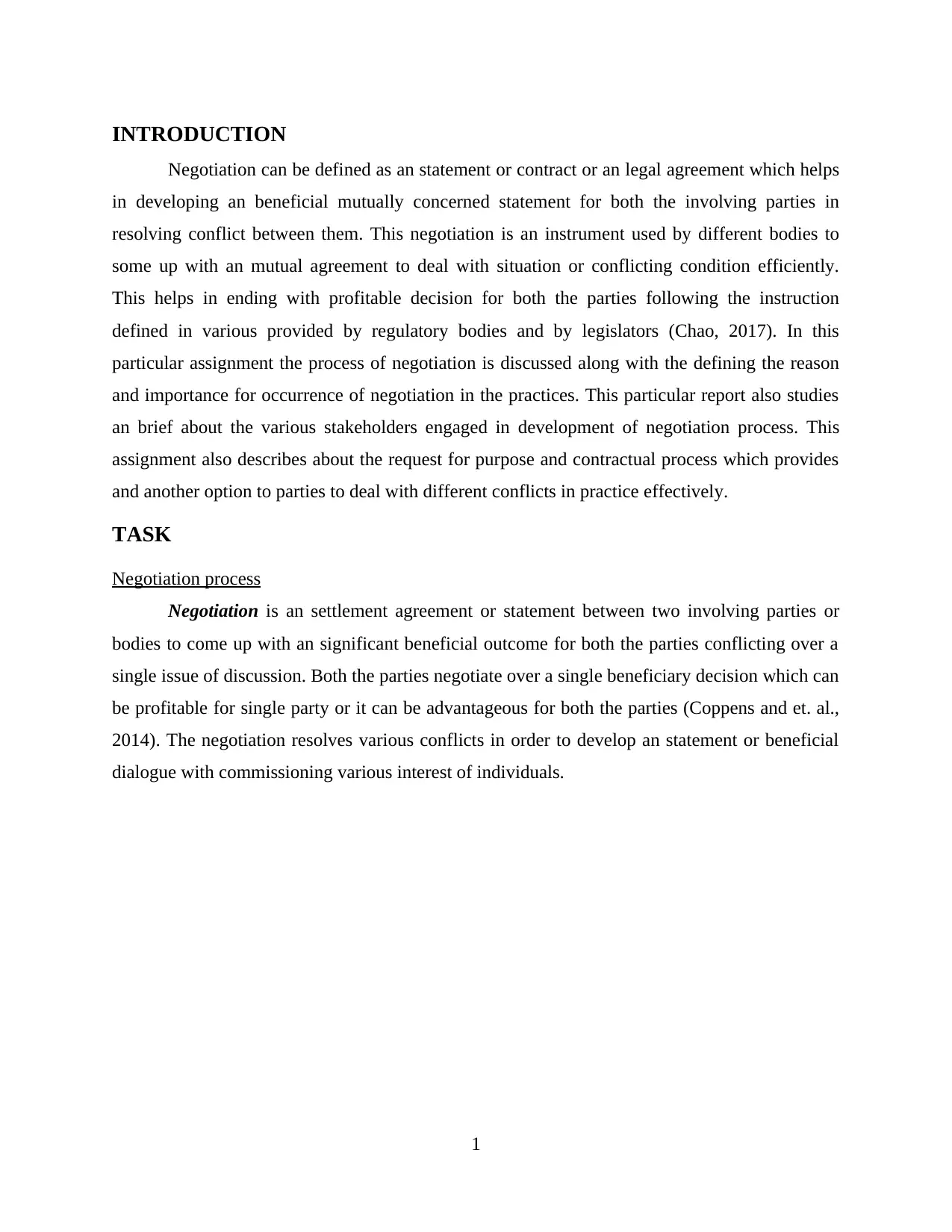
INTRODUCTION
Negotiation can be defined as an statement or contract or an legal agreement which helps
in developing an beneficial mutually concerned statement for both the involving parties in
resolving conflict between them. This negotiation is an instrument used by different bodies to
some up with an mutual agreement to deal with situation or conflicting condition efficiently.
This helps in ending with profitable decision for both the parties following the instruction
defined in various provided by regulatory bodies and by legislators (Chao, 2017). In this
particular assignment the process of negotiation is discussed along with the defining the reason
and importance for occurrence of negotiation in the practices. This particular report also studies
an brief about the various stakeholders engaged in development of negotiation process. This
assignment also describes about the request for purpose and contractual process which provides
and another option to parties to deal with different conflicts in practice effectively.
TASK
Negotiation process
Negotiation is an settlement agreement or statement between two involving parties or
bodies to come up with an significant beneficial outcome for both the parties conflicting over a
single issue of discussion. Both the parties negotiate over a single beneficiary decision which can
be profitable for single party or it can be advantageous for both the parties (Coppens and et. al.,
2014). The negotiation resolves various conflicts in order to develop an statement or beneficial
dialogue with commissioning various interest of individuals.
1
Negotiation can be defined as an statement or contract or an legal agreement which helps
in developing an beneficial mutually concerned statement for both the involving parties in
resolving conflict between them. This negotiation is an instrument used by different bodies to
some up with an mutual agreement to deal with situation or conflicting condition efficiently.
This helps in ending with profitable decision for both the parties following the instruction
defined in various provided by regulatory bodies and by legislators (Chao, 2017). In this
particular assignment the process of negotiation is discussed along with the defining the reason
and importance for occurrence of negotiation in the practices. This particular report also studies
an brief about the various stakeholders engaged in development of negotiation process. This
assignment also describes about the request for purpose and contractual process which provides
and another option to parties to deal with different conflicts in practice effectively.
TASK
Negotiation process
Negotiation is an settlement agreement or statement between two involving parties or
bodies to come up with an significant beneficial outcome for both the parties conflicting over a
single issue of discussion. Both the parties negotiate over a single beneficiary decision which can
be profitable for single party or it can be advantageous for both the parties (Coppens and et. al.,
2014). The negotiation resolves various conflicts in order to develop an statement or beneficial
dialogue with commissioning various interest of individuals.
1
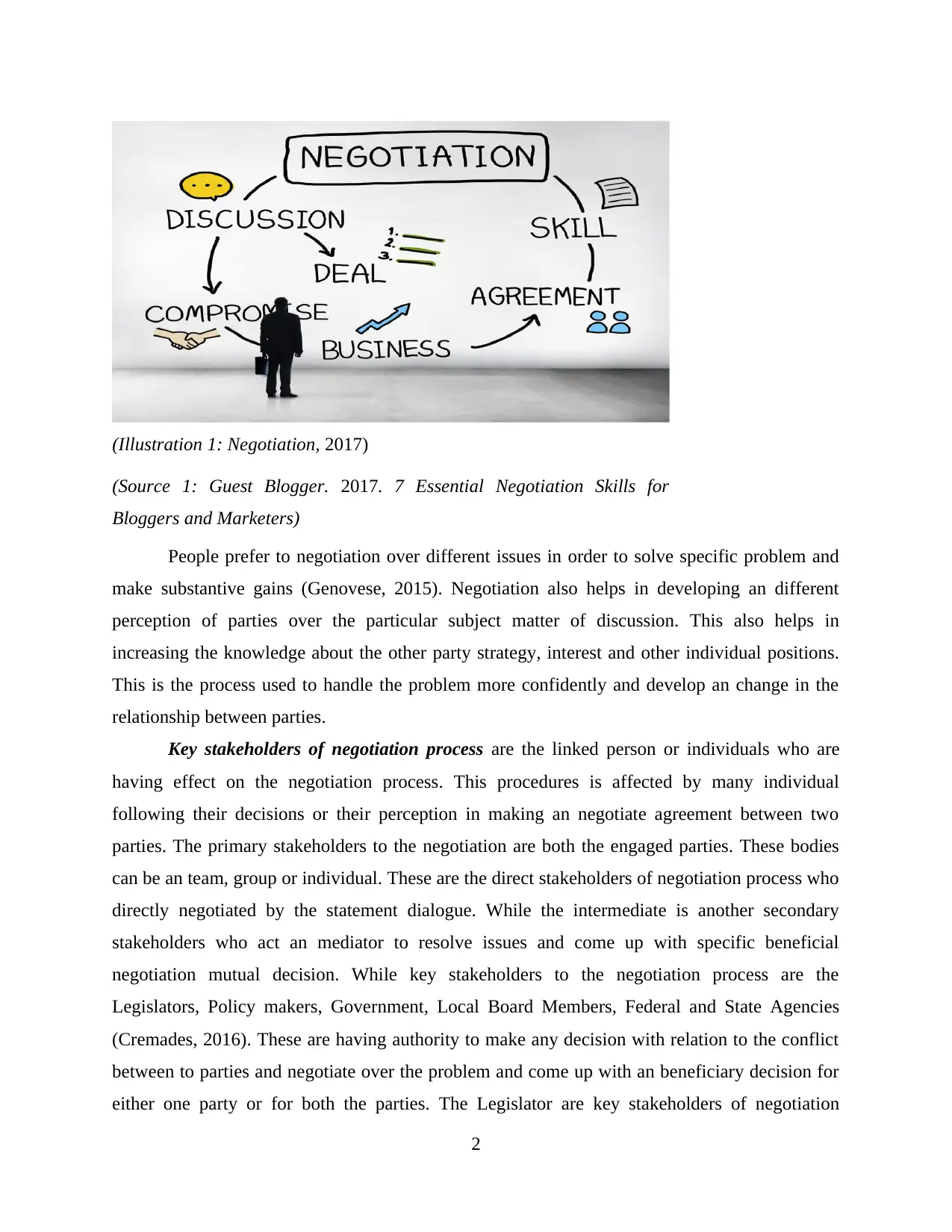
(Illustration 1: Negotiation, 2017)
(Source 1: Guest Blogger. 2017. 7 Essential Negotiation Skills for
Bloggers and Marketers)
People prefer to negotiation over different issues in order to solve specific problem and
make substantive gains (Genovese, 2015). Negotiation also helps in developing an different
perception of parties over the particular subject matter of discussion. This also helps in
increasing the knowledge about the other party strategy, interest and other individual positions.
This is the process used to handle the problem more confidently and develop an change in the
relationship between parties.
Key stakeholders of negotiation process are the linked person or individuals who are
having effect on the negotiation process. This procedures is affected by many individual
following their decisions or their perception in making an negotiate agreement between two
parties. The primary stakeholders to the negotiation are both the engaged parties. These bodies
can be an team, group or individual. These are the direct stakeholders of negotiation process who
directly negotiated by the statement dialogue. While the intermediate is another secondary
stakeholders who act an mediator to resolve issues and come up with specific beneficial
negotiation mutual decision. While key stakeholders to the negotiation process are the
Legislators, Policy makers, Government, Local Board Members, Federal and State Agencies
(Cremades, 2016). These are having authority to make any decision with relation to the conflict
between to parties and negotiate over the problem and come up with an beneficiary decision for
either one party or for both the parties. The Legislator are key stakeholders of negotiation
2
(Source 1: Guest Blogger. 2017. 7 Essential Negotiation Skills for
Bloggers and Marketers)
People prefer to negotiation over different issues in order to solve specific problem and
make substantive gains (Genovese, 2015). Negotiation also helps in developing an different
perception of parties over the particular subject matter of discussion. This also helps in
increasing the knowledge about the other party strategy, interest and other individual positions.
This is the process used to handle the problem more confidently and develop an change in the
relationship between parties.
Key stakeholders of negotiation process are the linked person or individuals who are
having effect on the negotiation process. This procedures is affected by many individual
following their decisions or their perception in making an negotiate agreement between two
parties. The primary stakeholders to the negotiation are both the engaged parties. These bodies
can be an team, group or individual. These are the direct stakeholders of negotiation process who
directly negotiated by the statement dialogue. While the intermediate is another secondary
stakeholders who act an mediator to resolve issues and come up with specific beneficial
negotiation mutual decision. While key stakeholders to the negotiation process are the
Legislators, Policy makers, Government, Local Board Members, Federal and State Agencies
(Cremades, 2016). These are having authority to make any decision with relation to the conflict
between to parties and negotiate over the problem and come up with an beneficiary decision for
either one party or for both the parties. The Legislator are key stakeholders of negotiation
2
⊘ This is a preview!⊘
Do you want full access?
Subscribe today to unlock all pages.

Trusted by 1+ million students worldwide
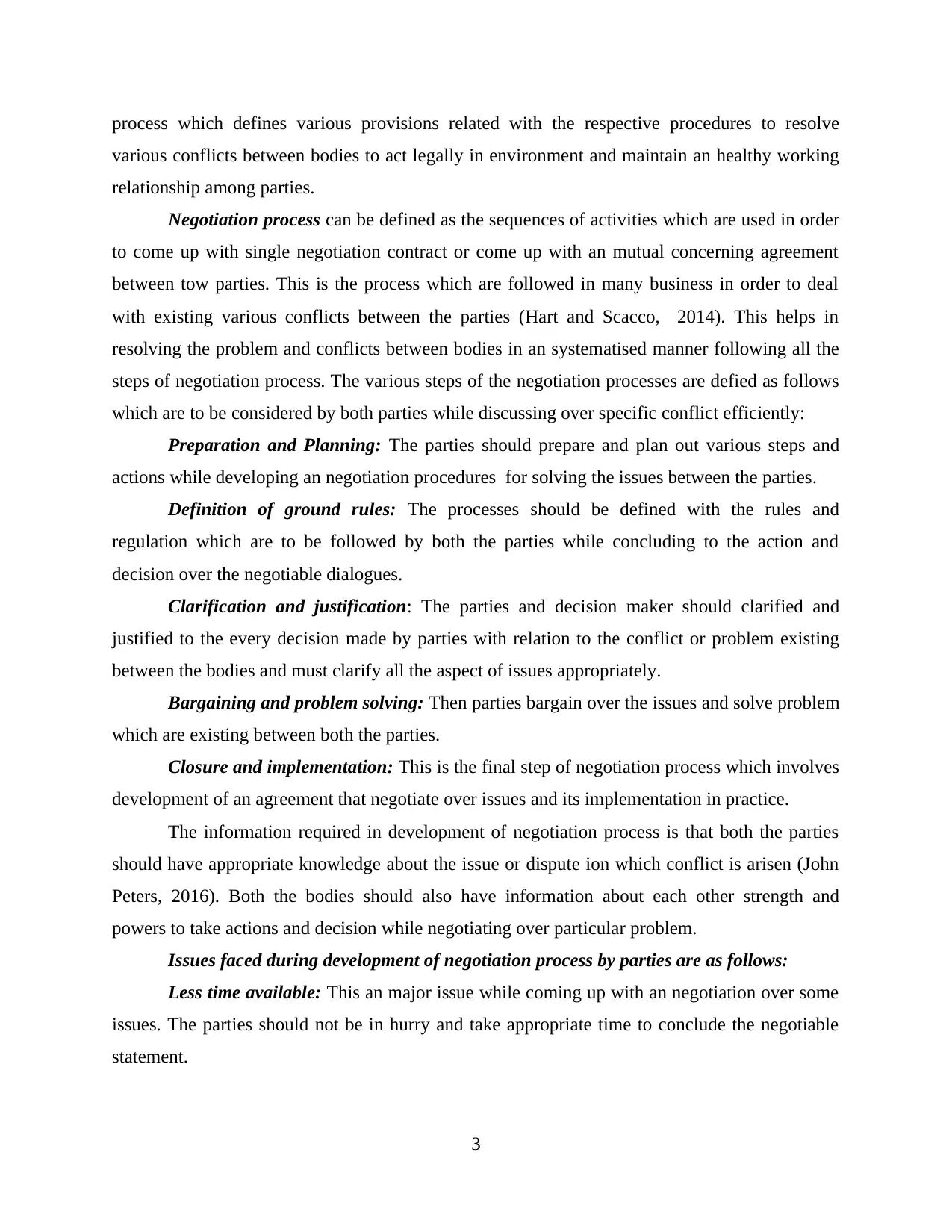
process which defines various provisions related with the respective procedures to resolve
various conflicts between bodies to act legally in environment and maintain an healthy working
relationship among parties.
Negotiation process can be defined as the sequences of activities which are used in order
to come up with single negotiation contract or come up with an mutual concerning agreement
between tow parties. This is the process which are followed in many business in order to deal
with existing various conflicts between the parties (Hart and Scacco, 2014). This helps in
resolving the problem and conflicts between bodies in an systematised manner following all the
steps of negotiation process. The various steps of the negotiation processes are defied as follows
which are to be considered by both parties while discussing over specific conflict efficiently:
Preparation and Planning: The parties should prepare and plan out various steps and
actions while developing an negotiation procedures for solving the issues between the parties.
Definition of ground rules: The processes should be defined with the rules and
regulation which are to be followed by both the parties while concluding to the action and
decision over the negotiable dialogues.
Clarification and justification: The parties and decision maker should clarified and
justified to the every decision made by parties with relation to the conflict or problem existing
between the bodies and must clarify all the aspect of issues appropriately.
Bargaining and problem solving: Then parties bargain over the issues and solve problem
which are existing between both the parties.
Closure and implementation: This is the final step of negotiation process which involves
development of an agreement that negotiate over issues and its implementation in practice.
The information required in development of negotiation process is that both the parties
should have appropriate knowledge about the issue or dispute ion which conflict is arisen (John
Peters, 2016). Both the bodies should also have information about each other strength and
powers to take actions and decision while negotiating over particular problem.
Issues faced during development of negotiation process by parties are as follows:
Less time available: This an major issue while coming up with an negotiation over some
issues. The parties should not be in hurry and take appropriate time to conclude the negotiable
statement.
3
various conflicts between bodies to act legally in environment and maintain an healthy working
relationship among parties.
Negotiation process can be defined as the sequences of activities which are used in order
to come up with single negotiation contract or come up with an mutual concerning agreement
between tow parties. This is the process which are followed in many business in order to deal
with existing various conflicts between the parties (Hart and Scacco, 2014). This helps in
resolving the problem and conflicts between bodies in an systematised manner following all the
steps of negotiation process. The various steps of the negotiation processes are defied as follows
which are to be considered by both parties while discussing over specific conflict efficiently:
Preparation and Planning: The parties should prepare and plan out various steps and
actions while developing an negotiation procedures for solving the issues between the parties.
Definition of ground rules: The processes should be defined with the rules and
regulation which are to be followed by both the parties while concluding to the action and
decision over the negotiable dialogues.
Clarification and justification: The parties and decision maker should clarified and
justified to the every decision made by parties with relation to the conflict or problem existing
between the bodies and must clarify all the aspect of issues appropriately.
Bargaining and problem solving: Then parties bargain over the issues and solve problem
which are existing between both the parties.
Closure and implementation: This is the final step of negotiation process which involves
development of an agreement that negotiate over issues and its implementation in practice.
The information required in development of negotiation process is that both the parties
should have appropriate knowledge about the issue or dispute ion which conflict is arisen (John
Peters, 2016). Both the bodies should also have information about each other strength and
powers to take actions and decision while negotiating over particular problem.
Issues faced during development of negotiation process by parties are as follows:
Less time available: This an major issue while coming up with an negotiation over some
issues. The parties should not be in hurry and take appropriate time to conclude the negotiable
statement.
3
Paraphrase This Document
Need a fresh take? Get an instant paraphrase of this document with our AI Paraphraser
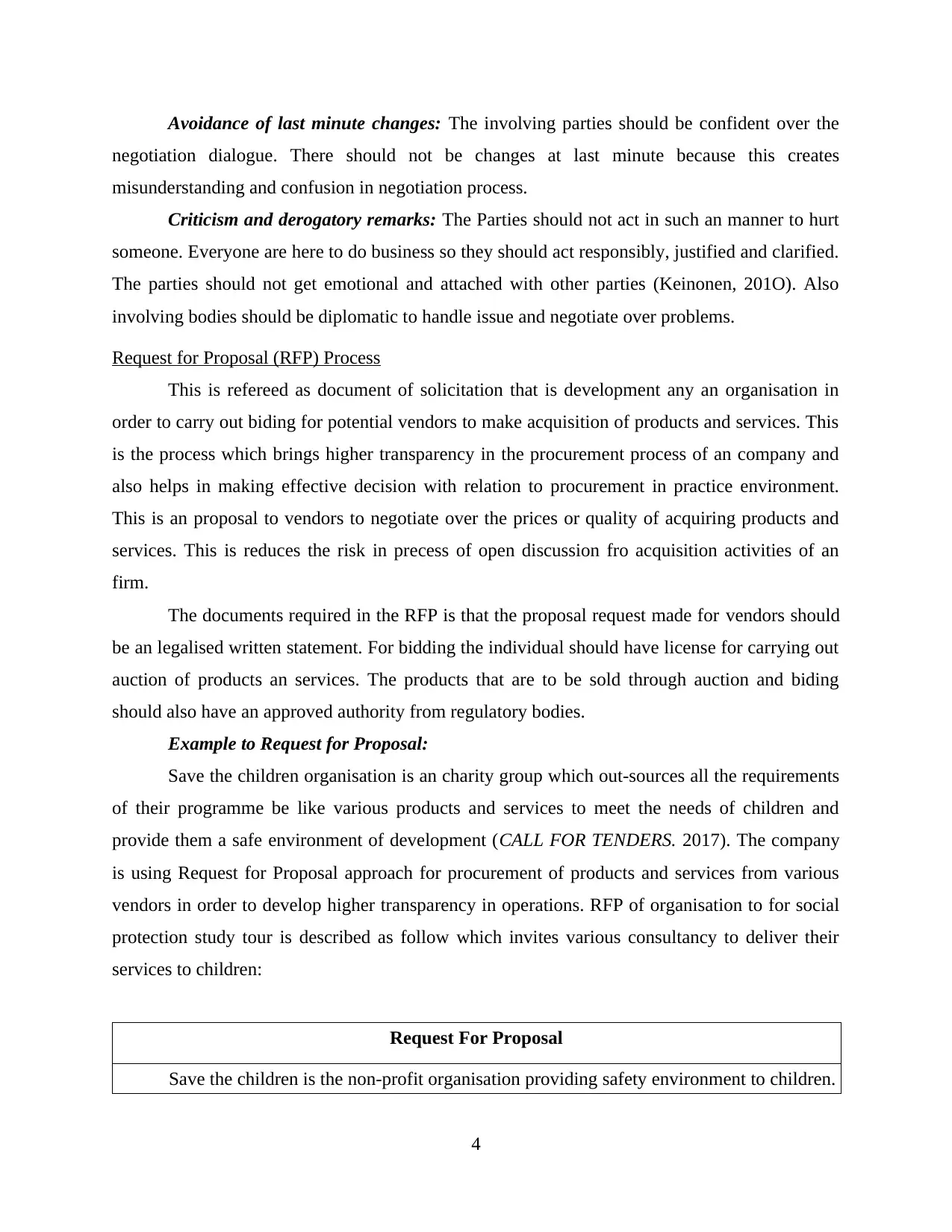
Avoidance of last minute changes: The involving parties should be confident over the
negotiation dialogue. There should not be changes at last minute because this creates
misunderstanding and confusion in negotiation process.
Criticism and derogatory remarks: The Parties should not act in such an manner to hurt
someone. Everyone are here to do business so they should act responsibly, justified and clarified.
The parties should not get emotional and attached with other parties (Keinonen, 201O). Also
involving bodies should be diplomatic to handle issue and negotiate over problems.
Request for Proposal (RFP) Process
This is refereed as document of solicitation that is development any an organisation in
order to carry out biding for potential vendors to make acquisition of products and services. This
is the process which brings higher transparency in the procurement process of an company and
also helps in making effective decision with relation to procurement in practice environment.
This is an proposal to vendors to negotiate over the prices or quality of acquiring products and
services. This is reduces the risk in precess of open discussion fro acquisition activities of an
firm.
The documents required in the RFP is that the proposal request made for vendors should
be an legalised written statement. For bidding the individual should have license for carrying out
auction of products an services. The products that are to be sold through auction and biding
should also have an approved authority from regulatory bodies.
Example to Request for Proposal:
Save the children organisation is an charity group which out-sources all the requirements
of their programme be like various products and services to meet the needs of children and
provide them a safe environment of development (CALL FOR TENDERS. 2017). The company
is using Request for Proposal approach for procurement of products and services from various
vendors in order to develop higher transparency in operations. RFP of organisation to for social
protection study tour is described as follow which invites various consultancy to deliver their
services to children:
Request For Proposal
Save the children is the non-profit organisation providing safety environment to children.
4
negotiation dialogue. There should not be changes at last minute because this creates
misunderstanding and confusion in negotiation process.
Criticism and derogatory remarks: The Parties should not act in such an manner to hurt
someone. Everyone are here to do business so they should act responsibly, justified and clarified.
The parties should not get emotional and attached with other parties (Keinonen, 201O). Also
involving bodies should be diplomatic to handle issue and negotiate over problems.
Request for Proposal (RFP) Process
This is refereed as document of solicitation that is development any an organisation in
order to carry out biding for potential vendors to make acquisition of products and services. This
is the process which brings higher transparency in the procurement process of an company and
also helps in making effective decision with relation to procurement in practice environment.
This is an proposal to vendors to negotiate over the prices or quality of acquiring products and
services. This is reduces the risk in precess of open discussion fro acquisition activities of an
firm.
The documents required in the RFP is that the proposal request made for vendors should
be an legalised written statement. For bidding the individual should have license for carrying out
auction of products an services. The products that are to be sold through auction and biding
should also have an approved authority from regulatory bodies.
Example to Request for Proposal:
Save the children organisation is an charity group which out-sources all the requirements
of their programme be like various products and services to meet the needs of children and
provide them a safe environment of development (CALL FOR TENDERS. 2017). The company
is using Request for Proposal approach for procurement of products and services from various
vendors in order to develop higher transparency in operations. RFP of organisation to for social
protection study tour is described as follow which invites various consultancy to deliver their
services to children:
Request For Proposal
Save the children is the non-profit organisation providing safety environment to children.
4
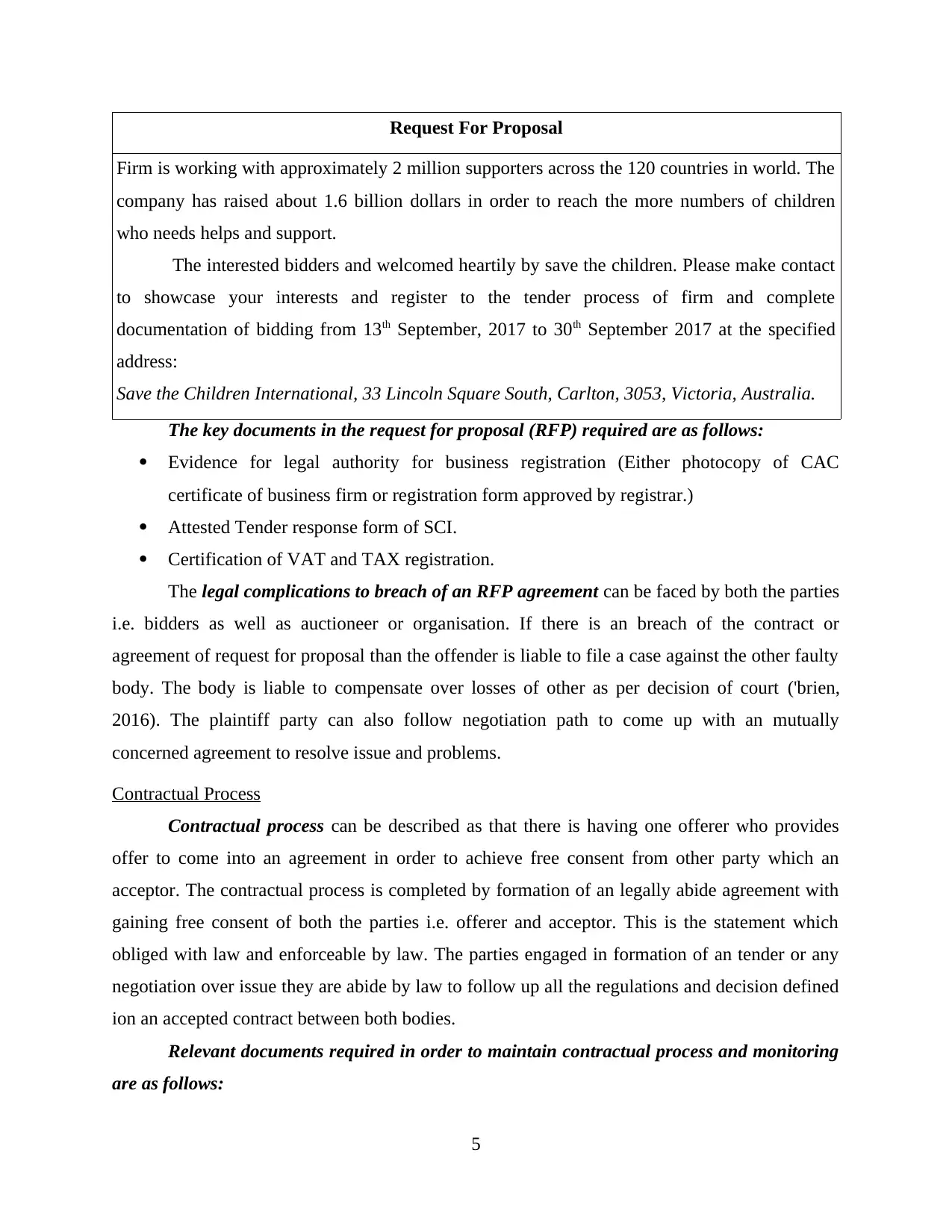
Request For Proposal
Firm is working with approximately 2 million supporters across the 120 countries in world. The
company has raised about 1.6 billion dollars in order to reach the more numbers of children
who needs helps and support.
The interested bidders and welcomed heartily by save the children. Please make contact
to showcase your interests and register to the tender process of firm and complete
documentation of bidding from 13th September, 2017 to 30th September 2017 at the specified
address:
Save the Children International, 33 Lincoln Square South, Carlton, 3053, Victoria, Australia.
The key documents in the request for proposal (RFP) required are as follows:
Evidence for legal authority for business registration (Either photocopy of CAC
certificate of business firm or registration form approved by registrar.)
Attested Tender response form of SCI.
Certification of VAT and TAX registration.
The legal complications to breach of an RFP agreement can be faced by both the parties
i.e. bidders as well as auctioneer or organisation. If there is an breach of the contract or
agreement of request for proposal than the offender is liable to file a case against the other faulty
body. The body is liable to compensate over losses of other as per decision of court ('brien,
2016). The plaintiff party can also follow negotiation path to come up with an mutually
concerned agreement to resolve issue and problems.
Contractual Process
Contractual process can be described as that there is having one offerer who provides
offer to come into an agreement in order to achieve free consent from other party which an
acceptor. The contractual process is completed by formation of an legally abide agreement with
gaining free consent of both the parties i.e. offerer and acceptor. This is the statement which
obliged with law and enforceable by law. The parties engaged in formation of an tender or any
negotiation over issue they are abide by law to follow up all the regulations and decision defined
ion an accepted contract between both bodies.
Relevant documents required in order to maintain contractual process and monitoring
are as follows:
5
Firm is working with approximately 2 million supporters across the 120 countries in world. The
company has raised about 1.6 billion dollars in order to reach the more numbers of children
who needs helps and support.
The interested bidders and welcomed heartily by save the children. Please make contact
to showcase your interests and register to the tender process of firm and complete
documentation of bidding from 13th September, 2017 to 30th September 2017 at the specified
address:
Save the Children International, 33 Lincoln Square South, Carlton, 3053, Victoria, Australia.
The key documents in the request for proposal (RFP) required are as follows:
Evidence for legal authority for business registration (Either photocopy of CAC
certificate of business firm or registration form approved by registrar.)
Attested Tender response form of SCI.
Certification of VAT and TAX registration.
The legal complications to breach of an RFP agreement can be faced by both the parties
i.e. bidders as well as auctioneer or organisation. If there is an breach of the contract or
agreement of request for proposal than the offender is liable to file a case against the other faulty
body. The body is liable to compensate over losses of other as per decision of court ('brien,
2016). The plaintiff party can also follow negotiation path to come up with an mutually
concerned agreement to resolve issue and problems.
Contractual Process
Contractual process can be described as that there is having one offerer who provides
offer to come into an agreement in order to achieve free consent from other party which an
acceptor. The contractual process is completed by formation of an legally abide agreement with
gaining free consent of both the parties i.e. offerer and acceptor. This is the statement which
obliged with law and enforceable by law. The parties engaged in formation of an tender or any
negotiation over issue they are abide by law to follow up all the regulations and decision defined
ion an accepted contract between both bodies.
Relevant documents required in order to maintain contractual process and monitoring
are as follows:
5
⊘ This is a preview!⊘
Do you want full access?
Subscribe today to unlock all pages.

Trusted by 1+ million students worldwide
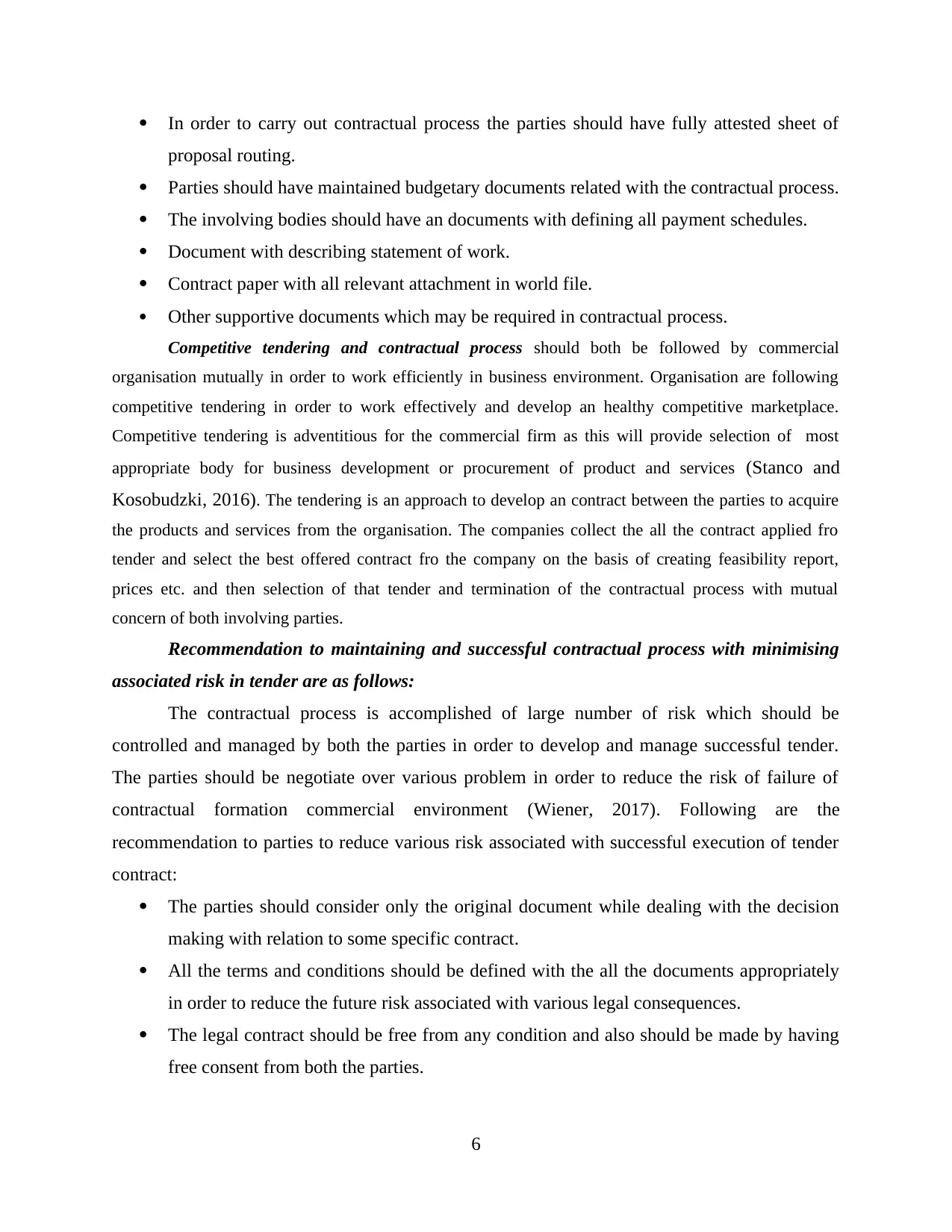
In order to carry out contractual process the parties should have fully attested sheet of
proposal routing.
Parties should have maintained budgetary documents related with the contractual process.
The involving bodies should have an documents with defining all payment schedules.
Document with describing statement of work.
Contract paper with all relevant attachment in world file.
Other supportive documents which may be required in contractual process.
Competitive tendering and contractual process should both be followed by commercial
organisation mutually in order to work efficiently in business environment. Organisation are following
competitive tendering in order to work effectively and develop an healthy competitive marketplace.
Competitive tendering is adventitious for the commercial firm as this will provide selection of most
appropriate body for business development or procurement of product and services (Stanco and
Kosobudzki, 2016). The tendering is an approach to develop an contract between the parties to acquire
the products and services from the organisation. The companies collect the all the contract applied fro
tender and select the best offered contract fro the company on the basis of creating feasibility report,
prices etc. and then selection of that tender and termination of the contractual process with mutual
concern of both involving parties.
Recommendation to maintaining and successful contractual process with minimising
associated risk in tender are as follows:
The contractual process is accomplished of large number of risk which should be
controlled and managed by both the parties in order to develop and manage successful tender.
The parties should be negotiate over various problem in order to reduce the risk of failure of
contractual formation commercial environment (Wiener, 2017). Following are the
recommendation to parties to reduce various risk associated with successful execution of tender
contract:
The parties should consider only the original document while dealing with the decision
making with relation to some specific contract.
All the terms and conditions should be defined with the all the documents appropriately
in order to reduce the future risk associated with various legal consequences.
The legal contract should be free from any condition and also should be made by having
free consent from both the parties.
6
proposal routing.
Parties should have maintained budgetary documents related with the contractual process.
The involving bodies should have an documents with defining all payment schedules.
Document with describing statement of work.
Contract paper with all relevant attachment in world file.
Other supportive documents which may be required in contractual process.
Competitive tendering and contractual process should both be followed by commercial
organisation mutually in order to work efficiently in business environment. Organisation are following
competitive tendering in order to work effectively and develop an healthy competitive marketplace.
Competitive tendering is adventitious for the commercial firm as this will provide selection of most
appropriate body for business development or procurement of product and services (Stanco and
Kosobudzki, 2016). The tendering is an approach to develop an contract between the parties to acquire
the products and services from the organisation. The companies collect the all the contract applied fro
tender and select the best offered contract fro the company on the basis of creating feasibility report,
prices etc. and then selection of that tender and termination of the contractual process with mutual
concern of both involving parties.
Recommendation to maintaining and successful contractual process with minimising
associated risk in tender are as follows:
The contractual process is accomplished of large number of risk which should be
controlled and managed by both the parties in order to develop and manage successful tender.
The parties should be negotiate over various problem in order to reduce the risk of failure of
contractual formation commercial environment (Wiener, 2017). Following are the
recommendation to parties to reduce various risk associated with successful execution of tender
contract:
The parties should consider only the original document while dealing with the decision
making with relation to some specific contract.
All the terms and conditions should be defined with the all the documents appropriately
in order to reduce the future risk associated with various legal consequences.
The legal contract should be free from any condition and also should be made by having
free consent from both the parties.
6
Paraphrase This Document
Need a fresh take? Get an instant paraphrase of this document with our AI Paraphraser
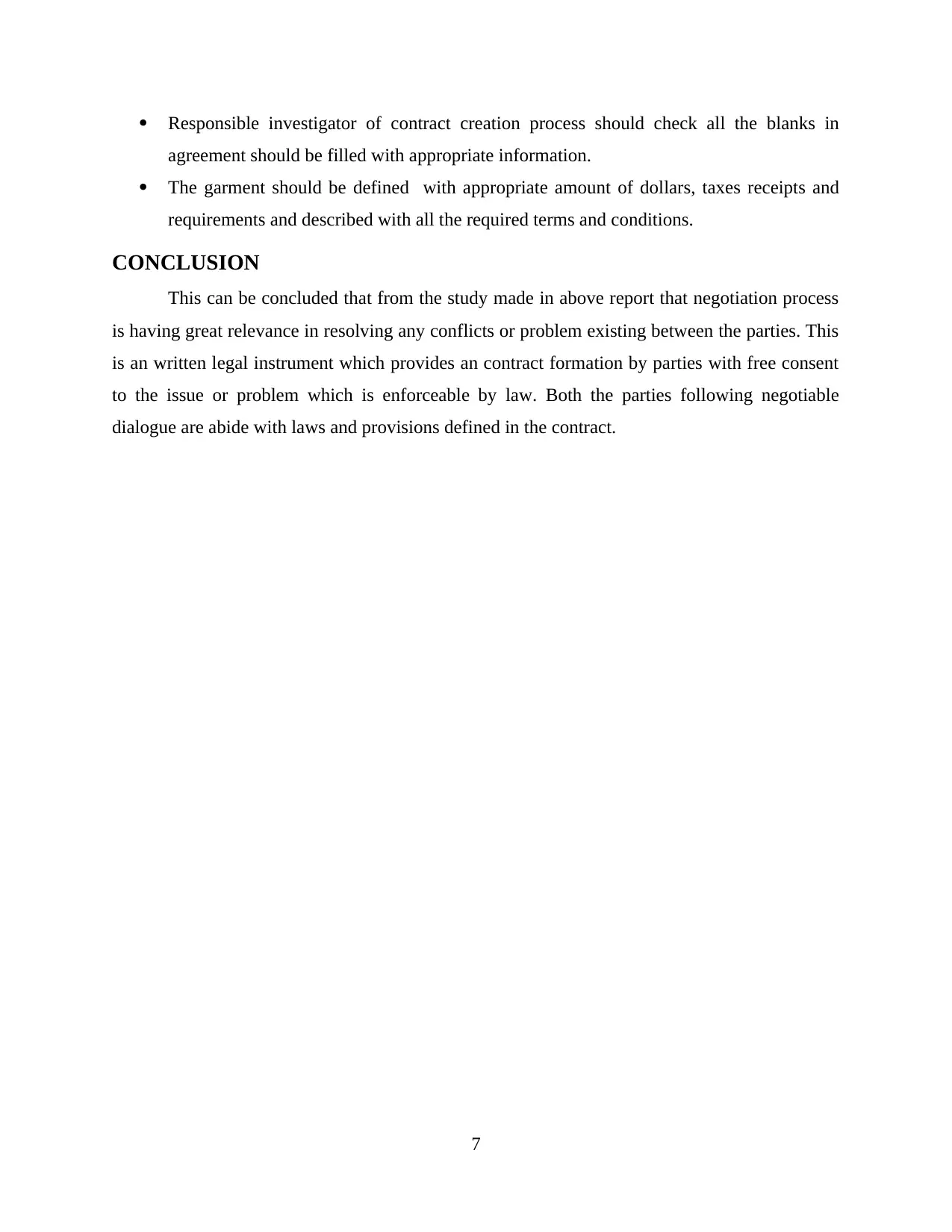
Responsible investigator of contract creation process should check all the blanks in
agreement should be filled with appropriate information.
The garment should be defined with appropriate amount of dollars, taxes receipts and
requirements and described with all the required terms and conditions.
CONCLUSION
This can be concluded that from the study made in above report that negotiation process
is having great relevance in resolving any conflicts or problem existing between the parties. This
is an written legal instrument which provides an contract formation by parties with free consent
to the issue or problem which is enforceable by law. Both the parties following negotiable
dialogue are abide with laws and provisions defined in the contract.
7
agreement should be filled with appropriate information.
The garment should be defined with appropriate amount of dollars, taxes receipts and
requirements and described with all the required terms and conditions.
CONCLUSION
This can be concluded that from the study made in above report that negotiation process
is having great relevance in resolving any conflicts or problem existing between the parties. This
is an written legal instrument which provides an contract formation by parties with free consent
to the issue or problem which is enforceable by law. Both the parties following negotiable
dialogue are abide with laws and provisions defined in the contract.
7
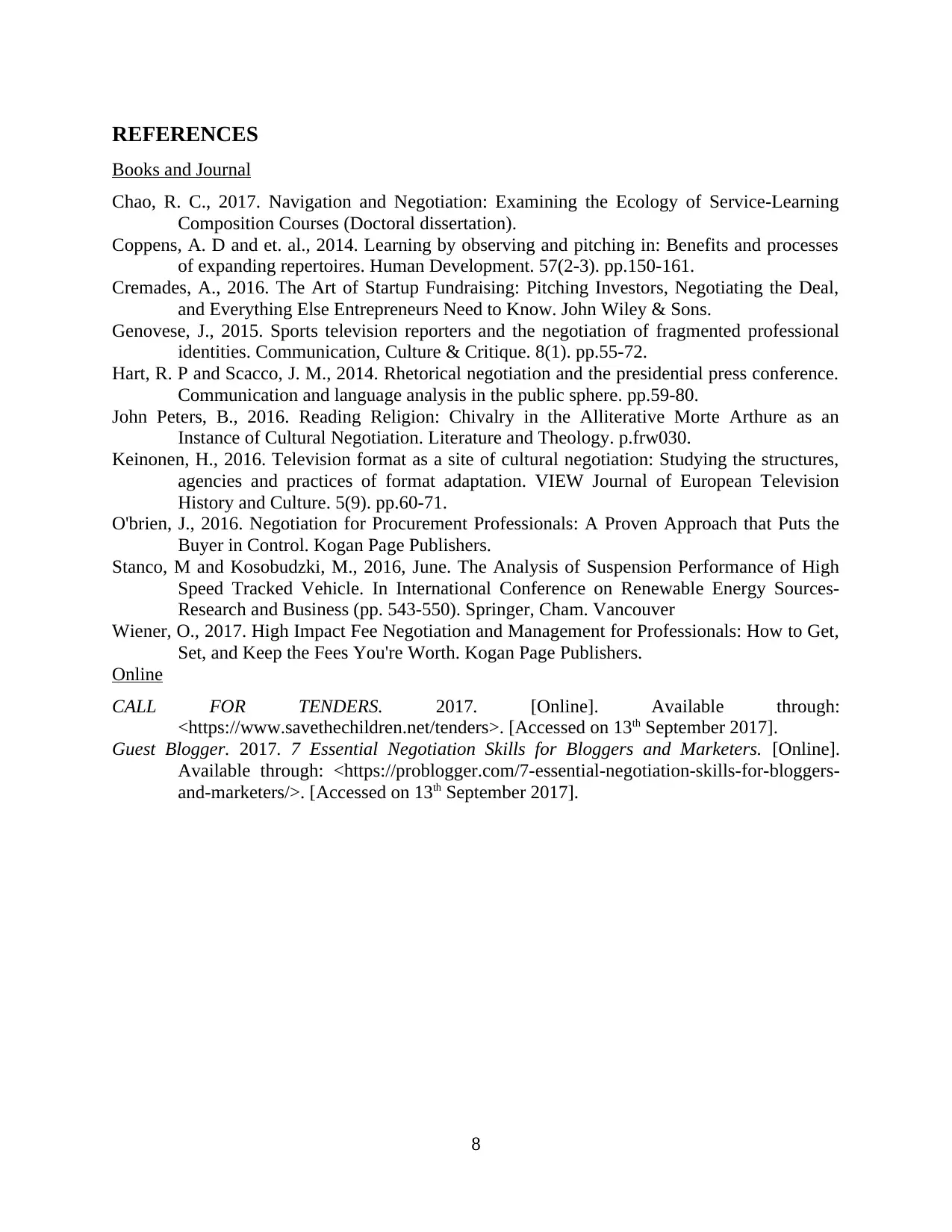
REFERENCES
Books and Journal
Chao, R. C., 2017. Navigation and Negotiation: Examining the Ecology of Service-Learning
Composition Courses (Doctoral dissertation).
Coppens, A. D and et. al., 2014. Learning by observing and pitching in: Benefits and processes
of expanding repertoires. Human Development. 57(2-3). pp.150-161.
Cremades, A., 2016. The Art of Startup Fundraising: Pitching Investors, Negotiating the Deal,
and Everything Else Entrepreneurs Need to Know. John Wiley & Sons.
Genovese, J., 2015. Sports television reporters and the negotiation of fragmented professional
identities. Communication, Culture & Critique. 8(1). pp.55-72.
Hart, R. P and Scacco, J. M., 2014. Rhetorical negotiation and the presidential press conference.
Communication and language analysis in the public sphere. pp.59-80.
John Peters, B., 2016. Reading Religion: Chivalry in the Alliterative Morte Arthure as an
Instance of Cultural Negotiation. Literature and Theology. p.frw030.
Keinonen, H., 2016. Television format as a site of cultural negotiation: Studying the structures,
agencies and practices of format adaptation. VIEW Journal of European Television
History and Culture. 5(9). pp.60-71.
O'brien, J., 2016. Negotiation for Procurement Professionals: A Proven Approach that Puts the
Buyer in Control. Kogan Page Publishers.
Stanco, M and Kosobudzki, M., 2016, June. The Analysis of Suspension Performance of High
Speed Tracked Vehicle. In International Conference on Renewable Energy Sources-
Research and Business (pp. 543-550). Springer, Cham. Vancouver
Wiener, O., 2017. High Impact Fee Negotiation and Management for Professionals: How to Get,
Set, and Keep the Fees You're Worth. Kogan Page Publishers.
Online
CALL FOR TENDERS. 2017. [Online]. Available through:
<https://www.savethechildren.net/tenders>. [Accessed on 13th September 2017].
Guest Blogger. 2017. 7 Essential Negotiation Skills for Bloggers and Marketers. [Online].
Available through: <https://problogger.com/7-essential-negotiation-skills-for-bloggers-
and-marketers/>. [Accessed on 13th September 2017].
8
Books and Journal
Chao, R. C., 2017. Navigation and Negotiation: Examining the Ecology of Service-Learning
Composition Courses (Doctoral dissertation).
Coppens, A. D and et. al., 2014. Learning by observing and pitching in: Benefits and processes
of expanding repertoires. Human Development. 57(2-3). pp.150-161.
Cremades, A., 2016. The Art of Startup Fundraising: Pitching Investors, Negotiating the Deal,
and Everything Else Entrepreneurs Need to Know. John Wiley & Sons.
Genovese, J., 2015. Sports television reporters and the negotiation of fragmented professional
identities. Communication, Culture & Critique. 8(1). pp.55-72.
Hart, R. P and Scacco, J. M., 2014. Rhetorical negotiation and the presidential press conference.
Communication and language analysis in the public sphere. pp.59-80.
John Peters, B., 2016. Reading Religion: Chivalry in the Alliterative Morte Arthure as an
Instance of Cultural Negotiation. Literature and Theology. p.frw030.
Keinonen, H., 2016. Television format as a site of cultural negotiation: Studying the structures,
agencies and practices of format adaptation. VIEW Journal of European Television
History and Culture. 5(9). pp.60-71.
O'brien, J., 2016. Negotiation for Procurement Professionals: A Proven Approach that Puts the
Buyer in Control. Kogan Page Publishers.
Stanco, M and Kosobudzki, M., 2016, June. The Analysis of Suspension Performance of High
Speed Tracked Vehicle. In International Conference on Renewable Energy Sources-
Research and Business (pp. 543-550). Springer, Cham. Vancouver
Wiener, O., 2017. High Impact Fee Negotiation and Management for Professionals: How to Get,
Set, and Keep the Fees You're Worth. Kogan Page Publishers.
Online
CALL FOR TENDERS. 2017. [Online]. Available through:
<https://www.savethechildren.net/tenders>. [Accessed on 13th September 2017].
Guest Blogger. 2017. 7 Essential Negotiation Skills for Bloggers and Marketers. [Online].
Available through: <https://problogger.com/7-essential-negotiation-skills-for-bloggers-
and-marketers/>. [Accessed on 13th September 2017].
8
⊘ This is a preview!⊘
Do you want full access?
Subscribe today to unlock all pages.

Trusted by 1+ million students worldwide
1 out of 12
Related Documents
Your All-in-One AI-Powered Toolkit for Academic Success.
+13062052269
info@desklib.com
Available 24*7 on WhatsApp / Email
![[object Object]](/_next/static/media/star-bottom.7253800d.svg)
Unlock your academic potential
Copyright © 2020–2025 A2Z Services. All Rights Reserved. Developed and managed by ZUCOL.



